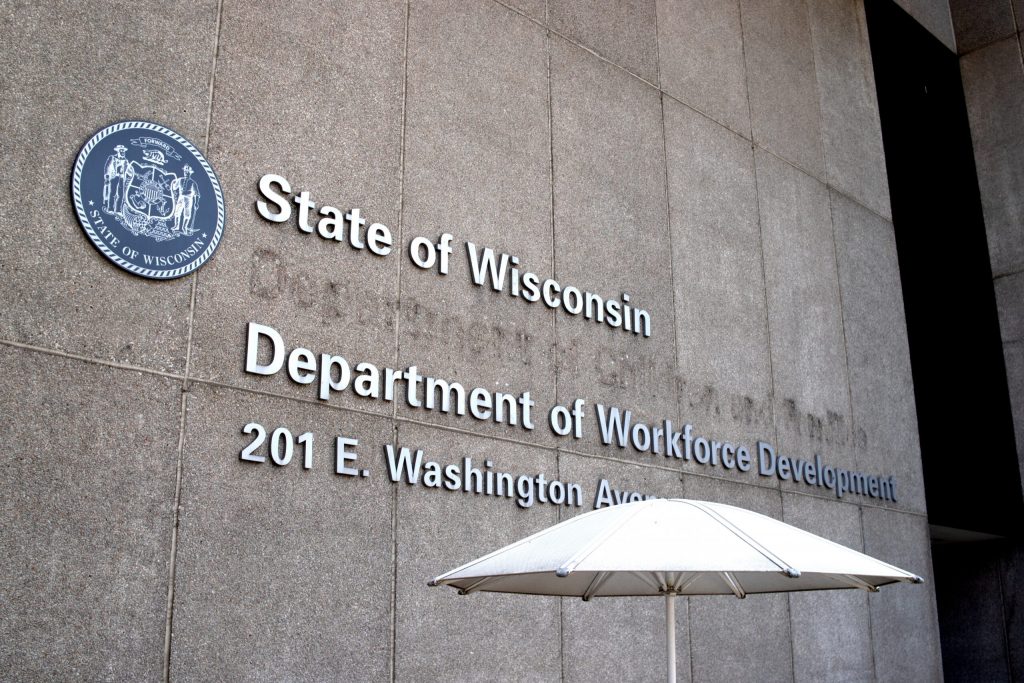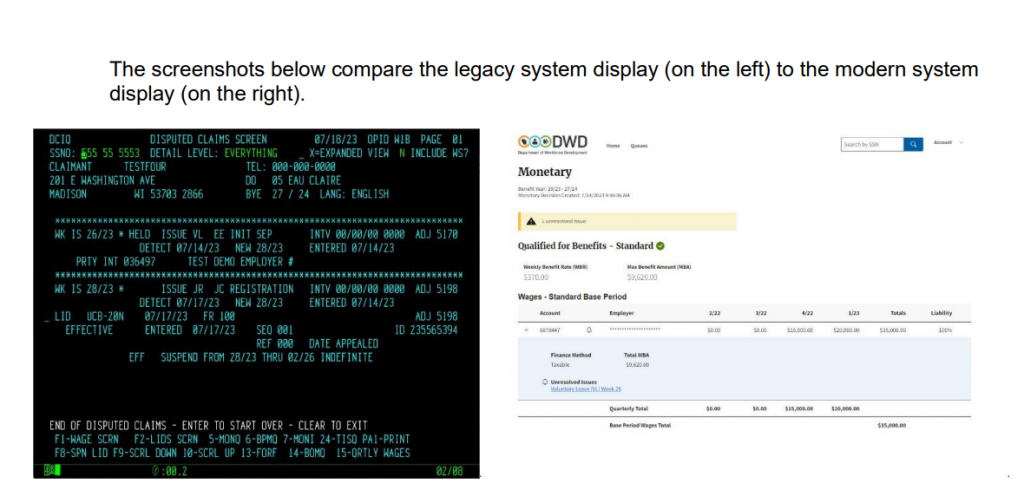Federal Funding Cut Imperils Wisconsin’s Unemployment System Update
System that buckled in 2020 was being updated, but work can't be completed without funding.

Outside the State of Wisconsin Department of Workforce Development building in Downtown Madison. Steven Potter/WPR
In the early days of the COVID-19 pandemic, when many businesses closed or laid off workers, a massive influx of 8.8 million unemployment claims overwhelmed Wisconsin’s aging unemployment insurance system.
That created a backlog of hundreds of thousands of claims. Many potential applicants weren’t able to connect to the department’s call center to complete the process and some Wisconsinites waited months without receiving a single unemployment payment.
She said DWD now has a digital portal for people to file unemployment claims and send documents online. The department also uses online chatbots to respond to questions in multiple languages, as well as uses artificial intelligence tools to assist with data entry.
“With these enhancements, the department is now paying 88 percent of all claims filed within three days or less,” Pechacek said. “That other 12 percent of claims that go a little bit longer are typically just because we have to do investigations if there’s some discrepancies between what the claimant and the employer are saying.”
In a letter to the Trump administration on Tuesday, Gov. Tony Evers said the administration is blocking nearly $30 million in federal funding to Wisconsin, which could prevent the state from finishing the project and potentially leave it vulnerable to cyberattacks and fraud.
“If the Trump Administration does not reverse course and provide the $29 million Wisconsin expected to receive, the state will not be able to complete its UI system modernization project,” Evers wrote to U.S. Labor Secretary Lori Chavez-DeRemer.
That funding was part of the American Rescue Plan Act, a pandemic recovery law signed by former President Joe Biden, and was being primarily used on anti-fraud measures, according to the governor’s office. Evers’ letter says the U.S. Labor Department “suddenly terminated” the funding in late May.
The termination halted work on identity authentication tools, a digital employer portal, artificial intelligence enhancements, fraud-prevention and cybersecurity tools, according to Pechacek. She said the employer portal was the DWD’s next major rollout and would have made it easier for employers to provide information to the state.
“The employer portal is really one of the largest losses from this federal action,” Pechacek said. “Our employers … have to submit quarterly wage information (and) verify claim information, and some of those components are still very antiquated.”

This image from a document the state Department of Workforce Development sent to the state Legislature shows the difference between the old user interface, left, and the new one, right. Photo courtesy of the Department of Workforce Development
Evers wrote that the Department of Labor “cited no objections” to those initiatives beyond “an unsupported assertion that they ‘no longer effectuate the Department’s priorities.’”
Pechacek said the state has already spent “slightly over half” of the $29 million. She said those grants were “reimbursement-based,” meaning the state first had to spend the money and then be paid back by the federal government.
The state appealed the Labor Department’s termination, and received a letter from the federal government in late July that “acknowledged the appeal while restating the Department’s earlier basis for termination,” the governor’s letter states.
“The people of Wisconsin deserve systems that function, state of the art, with high integrity and accuracy,” Pechacek said. “We are also going to pursue litigation to reclaim the funds which were rightfully awarded to us already and improperly rescinded.”
In addition to the $29 million in lost funding, the project was using $80 million from a different program under the American Rescue Plan Act, according to a report sent to the Legislature’s budget committee. The document states that the $80 million has not been impacted but is “insufficient to support the full modernization work.”
Pechacek said DWD has also asked the state Legislature to allocate additional state funds toward finishing the effort but said there hasn’t been much movement on that front.
Wisconsin isn’t the only state that’s had federal funding to upgrade unemployment systems clawed back by the Trump administration. In May, Axios reported the White House terminated $400 million of that funding across the country. A July report from state agencies said $675 million in grants awarded to unemployment programs in over 30 states and territories had been terminated.
The U.S. Department of Labor did not immediately respond to WPR’s request for comment. In May, the federal agency told Axios in a statement that the unemployment modernization funding was “squandered” on “bureaucratic and wasteful projects that focused on equitable access rather than advancing access for all Americans in need.”
In the letter, Evers also said failing to complete Wisconsin’s modernization effort would put the state’s unemployment system at risk of becoming overwhelmed again during any future economic downturn. He says that would “create acute hardship for Wisconsin families.”
“It is our obligation to prevent this scenario from coming to pass,” Evers wrote. “I urge you to reverse the decision to defund these critical government efficiency and fraud prevention initiatives.”
“Any time we don’t fully invest in upgrading and reach the programmatic goals that we have set to get fully off of the antiquated systems, we are at risk to be overwhelmed again,” she said. “All of that leads us to be more vulnerable, in a time of significant increase of accessing the system, to the cyber attacks, to fraudulent efforts, to being compromised.”
Federal funding cut endangers state unemployment system update was originally published by Wisconsin Public Radio.
If you think stories like this are important, become a member of Urban Milwaukee and help support real, independent journalism. Plus you get some cool added benefits.



















